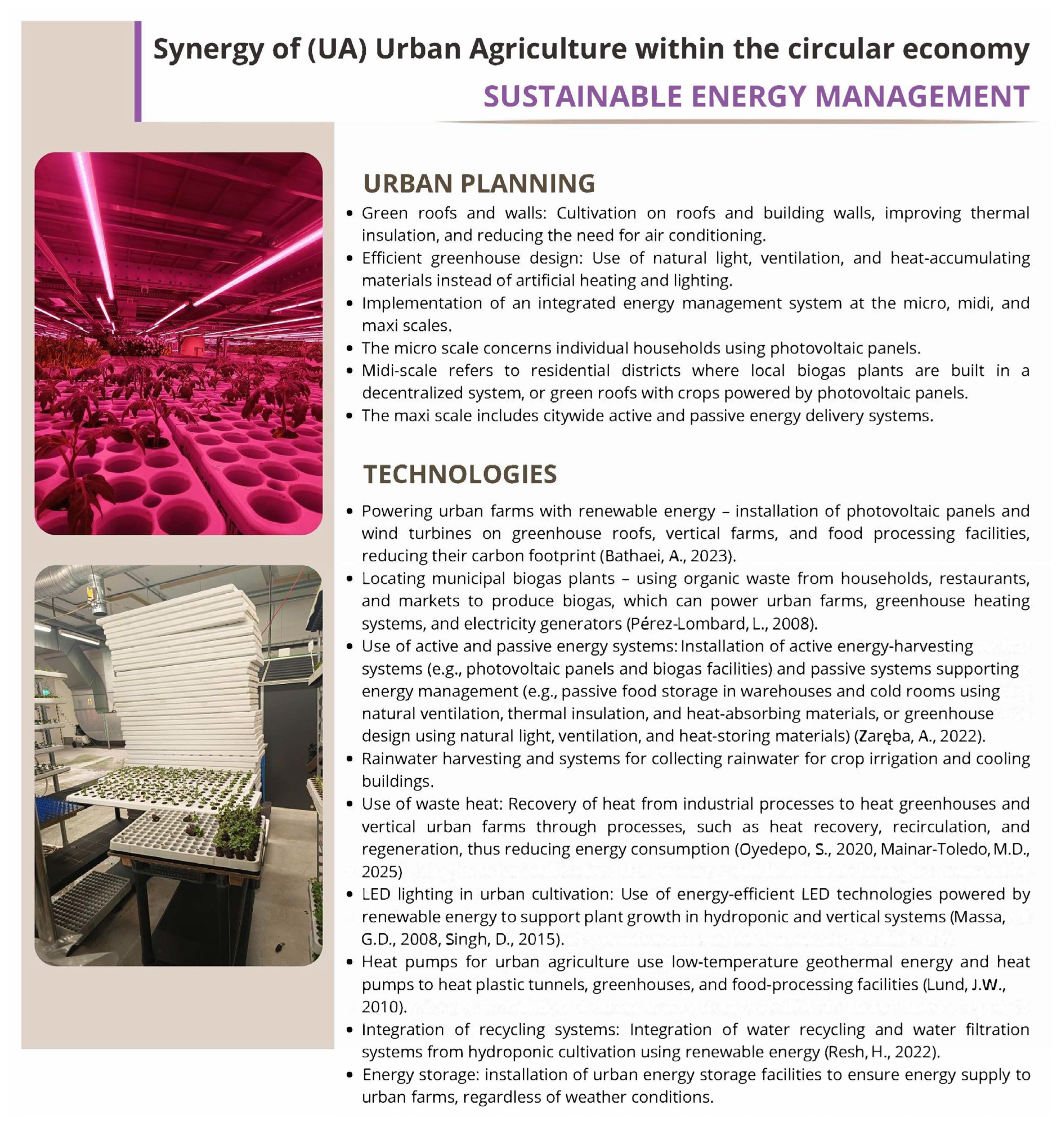Urban Harvesting: Building Resilience Through Circular Agriculture
Abstract
1. Introduction
2. Materials and Methods
2.1. Conceptual and Methodological Framework
2.2. The Context of Urban Agriculture and the Circular Economy
2.3. Closed Loops in Urban Agriculture and Sustainable Urban Development: Goals and Strategies
2.3.1. Increasing Access to Local, Fresh, and Organic Food
2.3.2. Promoting Bio-Architectural Projects for Urban Agriculture
2.3.3. Reducing Food Waste in the Spirit of the Circular Economy
2.3.4. Reducing Environmental Impact Through Efficient Resource Use (Own Elaboration)
2.3.5. Building Climate Resilience Through Blue-Green Infrastructure
2.3.6. Sustainable Food Distribution Systems
2.3.7. Environmental Education and Resident Engagement
3. Research
3.1. Organic Waste Management in Cities—A Circular Approach
3.2. Sustainable Water Management in the Circular Economy
3.3. Sustainable Energy Management in Circular Economy
3.4. Development of New Forms of Urban Agriculture
3.5. Transport in Circular Economy
3.6. Environmental Education and Community Engagement
4. Multiscale Model of Synergy Between Urban Agriculture and the Urban Environment Within a Circular Economy
5. Discussion
6. Conclusions
Author Contributions
Funding
Institutional Review Board Statement
Informed Consent Statement
Data Availability Statement
Conflicts of Interest
Abbreviations
| AHP | Analytic Hierarchy Process | OPEX | Operational Expenditures |
| BGI | Blue–Green Infrastructure | PPA | Power Purchase Agreement |
| CAPEX | Capital Expenditures | PPP | Public–Private Partnership |
| CEA | Controlled Environment Agriculture | SDG | Sustainable Development Goals |
| CE | Circular Economy | SOP | Standard Operating Procedure |
| CUA | Circular Urban Agriculture | SuDS | Sustainable Drainage Systems |
| ESCO | Energy Service Company | SUMP | Sustainable Urban Mobility Plan |
| HVAC | Heating, Ventilation, and Air Conditioning | TEA | Techno-Economic Assessment |
| IoT | Internet of Things | UA | Urban Agriculture |
| LCA | Life Cycle Assessment | LID | Low-Impact Development |
References
- Fattibene, D.; Recanati, F.; Dembska, K.; Antonelli, M. Urban food waste: A framework to analyse policies and initiatives. Resources 2020, 9, 99. [Google Scholar] [CrossRef]
- De Jesus, A.; Aguiar Borges, L. Pathways for cleaner, greener, healthier cities: What is the role of urban agriculture in the circular economy of two Nordic cities? Sustainability 2024, 16, 1258. [Google Scholar] [CrossRef]
- Sarangi, P.K.; Pal, P.; Singh, A.K.; Sahoo, U.K.; Prus, P. Food waste to food security: Transition from bioresources to sustainability. Resources 2024, 13, 164. [Google Scholar] [CrossRef]
- Angulo, M.G.; Batista, M.T.; Caicedo, M.I.G. Advances and challenges of a circular economy in agriculture in Ibero-America: A bibliometric perspective. Sustainability 2024, 16, 11266. [Google Scholar] [CrossRef]
- Kohli, K.; Prajapati, R.; Shah, R.; Das, M.; Sharma, B. Food waste: Environmental impact and possible solutions. Sustain. Food Technol. 2023, 2, 70–80. [Google Scholar] [CrossRef]
- Tabrez, Z. Sustainable Cities: Enhancing Food Systems with Urban Agriculture; Springer: Berlin/Heidelberg, Germany, 2025. [Google Scholar] [CrossRef]
- Berry, B.; Blackmer, T.; Haedicke, M.; Lee, S.; MacRae, J.D.; Miller, T.R.; Nayak, B.; Rivet-Préfontaine, L.; Saber, D.; Silka, L.; et al. Safe circular food systems: A transdisciplinary approach to identify emergent risks in food waste nutrient cycling. Foods 2024, 13, 2374. [Google Scholar] [CrossRef] [PubMed]
- Annual Report 2024. United Nations. Available online: https://www.un.org/en/annualreport (accessed on 15 September 2025).
- Eurostat. 2023. Available online: https://ec.europa.eu/eurostat/web/main/home (accessed on 14 September 2025).
- Krzemińska, A.; Zaręba, A.; Adynkiewicz-Piragas, M.; Jia, H.; Alpuche Cruz, M.G.; Valle Cordero, L.A. Underground Food Farms as a Climate-Friendly Alternative Form of Urban Agriculture. Sustainability 2025, 17, 9392. [Google Scholar] [CrossRef]
- Manono, B.O. Small-Scale Farming in the United States: Challenges and Pathways to Enhanced Productivity and Profitability. Sustainability 2025, 17, 6752. [Google Scholar] [CrossRef]
- Guerrero-Villegas, W.; Rosero-Rosero, M.; Layana-Bajana, E.-M.; Villares-Villafuerte, H. Circular Agriculture Models: A Systematic Review of Academic Contributions. Sustainability 2025, 17, 7146. [Google Scholar] [CrossRef]
- Lin, X.; Dąbrowski, M.; Qu, L.; Hausleitner, B.; Rocco, R. Urban Regeneration Through Circularity: Exploring the Potential of Circular Development in the Urban Villages of Chengdu, China. Land 2025, 14, 655. [Google Scholar] [CrossRef]
- Menyuka, N.N.; Sibanda, M.; Bob, U. Perceptions of the Challenges and Opportunities of Utilising Organic Waste through Urban Agriculture in the Durban South Basin. Int. J. Environ. Res. Public Health 2020, 17, 1158. [Google Scholar] [CrossRef] [PubMed]
- Wang, N.; Bai, Y.; Guo, Z.; Fan, Y.; Meng, F. Synergies between the circular economy and carbon emission reduction. Sci. Total Environ. 2024, 951, 175603. [Google Scholar] [CrossRef]
- Varella, W.A.; Oliveira Neto, G.C.d.; Stefani, E.; Costa, I.; Monteiro, R.C.; Conde, W.; da Silva Junior, W.; Baptestone, R.C.; Goes, R.d.S.; Riccotta, R.; et al. Integrated Service Architecture to Promote the Circular Economy in Agriculture 4.0. Sustainability 2024, 16, 2535. [Google Scholar] [CrossRef]
- Ghormare, R.; Fatima, S.; Grover, P.; Phutela, N.; Kandpal, V.; Santibanez, E. Exploring the paradigm shift towards sustainability: A systematic literature review on circular economy and eco-innovation. AIMS Environ. Sci. 2024, 11, 940–959. [Google Scholar] [CrossRef]
- Gill, S.; Handley, J.F.; Ennos, R.; Pauleit, S. Adapting cities for climate change: The role of the green infrastructure. Built Environ. 2024, 33, 115–133. [Google Scholar] [CrossRef]
- Polo, J.D.A.; Toboso-Chavero, S.; Adhikari, B.; Villalba, G. Closing the nutrient cycle in urban areas: The use of municipal solid waste in peri-urban and urban agriculture. Waste Manag. 2024, 183, 220–231. [Google Scholar] [CrossRef] [PubMed]
- Vaneeckhaute, C.; Lebuf, V.; Michels, E.; Belia, E.; Vanrolleghem, P.A.; Tack, F.M.; Meers, E. Nutrient recovery from digestate: Systematic technology review and product classification. Waste Biomass Valor. 2017, 8, 21–40. [Google Scholar] [CrossRef]
- Sanyé-Mengual, E.; Oliver-Solà, J.; Montero, J.I.; Rieradevall, J. An environmental and economic life cycle assessment of rooftop greenhouse (RTG) implementation in Barcelona, Spain. Int. J. Life Cycle Assess. 2015, 20, 350–366. [Google Scholar] [CrossRef]
- Martin, M.; Molin, E. Environmental assessment of an urban vertical hydroponic farming system in Sweden. Sustainability 2019, 11, 4142. [Google Scholar] [CrossRef]
- Zezza, A.; Tasciotti, L. Urban agriculture, poverty, and food security: Empirical evidence from a sample of developing countries. Food Policy 2010, 35, 265–273. [Google Scholar] [CrossRef]
- Aubry, C.; Ramamonjisoa, J.; Dabat, M.-H.; Rakotoarisoa, J.; Rakotondraibe, J.; Rabeharisoa, L. Urban agriculture and land use in cities: An approach with the multi-functionality and sustainability concepts in the case of Antananarivo (Madagascar). Land Use Policy 2012, 29, 429–439. [Google Scholar] [CrossRef]
- McClintock, N. Radical, reformist, and garden-variety neoliberal: Coming to terms with urban agriculture’s contradictions. Local Environ. 2013, 19, 147–171. [Google Scholar] [CrossRef]
- Hodbod, J.; Eakin, H. Adapting a social-ecological resilience framework for food systems. J. Environ. Stud. Sci. 2015, 5, 474–484. [Google Scholar] [CrossRef]
- The New Urban Agenda; United Nations. 2016. Available online: https://digitallibrary.un.org/record/858344?v=pdf (accessed on 12 November 2025).
- The State of Food and Agriculture 2018, Food and Agriculture Organization of the United Nations (FAO). Available online: http://www.fao.org/3/I9549EN/i9549en.pdf (accessed on 12 November 2025).
- Li, L.; Long, D. Who values urban community gardens and how much? Food Policy. 2015, 126, 102649. [Google Scholar] [CrossRef]
- Boukharta, O.F.; Huang, I.; Vickers, L.; Santamarta, L.; Gracia, L. Benefits of non-commercial urban agricultural practices: A systematic literature review. Agronomy 2024, 14, 234. [Google Scholar] [CrossRef]
- Lopez-Muñoz, F.; Soto-Bruna, W.; Baptiste, B.L.G.; Leon-Pulido, J. Evaluating Food Resilience Initiatives Through Urban Agriculture Models: A Critical Review. Sustainability 2025, 17, 2994. [Google Scholar] [CrossRef]
- Nogeire, T.; Ryan, E.; Jablonski, B.; Carolan, M.; Seshadri, A.; Brown, C.; Honarchian Saki, H.; McKeen, S.; Lapansky, E.; Schipanski, M. The role of urban agriculture in a secure, healthy, and sustainable food system. BioScience 2018, 68, 748–759. [Google Scholar] [CrossRef]
- Daneshyar, E. Residential rooftop urban agriculture: Architectural design recommendations. Sustainability 2024, 16, 1881. [Google Scholar] [CrossRef]
- Ansar, A.; Du, J.; Javed, Q.; Adnan, M.; Javaid, I. Biodegradable waste in compost production: A review of its economic potential. Nitrogen 2025, 6, 24. [Google Scholar] [CrossRef]
- Majewski, E.; Komerska, A.; Kwiatkowski, J.; Malak Rawlikowska, A.; Was, A.; Sulewski, P.; Gołaś, M.; Jurek, K.; Lecoeur, J.-L.; Tocco, B.; et al. Are short food supply chains more environmentally sustainable than long chains? A life cycle assessment (LCA) of the eco-efficiency of food chains in selected EU countries. Energies 2020, 13, 4853. [Google Scholar] [CrossRef]
- Vasiutina, H.; Naumov, V.; Szarata, A.; Rybicki, S. Estimating the emissions reduction due to the use of cargo bikes: Case studies for the selected European cities. Energies 2022, 15, 5264. [Google Scholar] [CrossRef]
- Erälinna, L.; Szymoniuk, B. Managing a circular food system in sustainable urban farming: Experimental research at the Turku University Campus (Finland). Sustainability 2021, 13, 6231. [Google Scholar] [CrossRef]
- Sosunova, I.; Porras, J. IoT-enabled smart waste management systems for smart cities: A systematic review. IEEE Access 2022, 10, 73326–73363. [Google Scholar] [CrossRef]
- Cardenas, M.; Schivinski, B.; Brennan, L. Circular practices in the hospitality sector regarding food waste. J. Clean. Prod. 2024, 472, 143452. [Google Scholar] [CrossRef]
- Awino, F.B.; Apitz, S.E. Solid waste management in the context of the waste hierarchy and circular economy frameworks: An international critical review. Integr. Environ. Assess. Manag. 2024, 20, 9–35. [Google Scholar] [CrossRef]
- Ebissa, G.; Yeshitela, K.; Desta, H.; Fetene, A. Urban agriculture and environmental sustainability. Environ. Dev. Sustain. 2023, 26, 14583–14599. [Google Scholar] [CrossRef]
- Larsen, T.; Hoffmann, S.; Luthi, C.; Truffer, B.; Maurer, M. Emerging solutions to the water challenges of an urbanizing world. Science 2016, 352, 928–933. [Google Scholar] [CrossRef]
- Pearlmutter, D.; Pucher, B.; Calheiros, C.S.C.; Hoffmann, K.A.; Aicher, A.; Pinho, P.; Stracqualursi, A.; Korolova, A.; Pobric, A.; Galvão, A.; et al. Closing water cycles in the built environment through nature-based solutions: The contribution of vertical greening systems and green roofs. Water 2021, 13, 2165. [Google Scholar] [CrossRef]
- Pestisha, A.; Gabnai, Z.; Chalgynbayeva, A.; Lengyel, P.; Bai, A. On-Farm Renewable Energy Systems: A Systematic Review. Energies 2023, 16, 862. [Google Scholar] [CrossRef]
- Specht, K.; Siebert, R.; Hartmann, I.; Freisinger, U.B.; Sawicka, M.; Werner, A.; Thomaier, S.; Henckel, D.; Walk, H.; Dierich, A. Urban agriculture of the future: An overview of sustainability aspects of food production in and on buildings. Agric. Hum. Values 2014, 31, 33–51. [Google Scholar] [CrossRef]
- Bathaei, A.; Štreimikienė, D. Renewable Energy and Sustainable Agriculture: Review of Indicators. Sustainability 2023, 15, 14307. [Google Scholar] [CrossRef]
- Pérez-Lombard, L.; Ortiz, J.; Pout, C. A review on buildings energy consumption information. Energy Build. 2008, 40, 394–398. [Google Scholar] [CrossRef]
- Zaręba, A.; Krzemińska, A.; Kozik, R.; Adynkiewicz-Piragas, M.; Kristiánová, K. Passive and Active Solar Systems in Eco-Architecture and Eco-Urban Planning. Appl. Sci. 2022, 12, 3095. [Google Scholar] [CrossRef]
- Oyedepo, S.; Adebayo, B.A. Waste heat recovery technologies: Pathway to sustainable energy development. J. Therm. Eng. 2020, 7, 324–348. [Google Scholar] [CrossRef]
- Mainar-Toledo, M.D.; González García, I.; Leiva, H.; Fraser, J.; Persson, D.; Parker, T. Environmental and Economic Benefits of Waste Heat Recovery as a Symbiotic Scenario in Sweden. Energies 2025, 18, 1636. [Google Scholar] [CrossRef]
- Massa, G.D.; Kim, H.-H.; Wheeler, R.M.; Mitchell, C.A. Plant productivity in response to LED lighting. HortScience 2008, 43, 1951–1956. [Google Scholar] [CrossRef]
- Singh, D.; Basu, C.; Meinhardt-Wollweber, M.; Roth, B. LEDs for energy efficient greenhouse lighting. Renew. Sustain. Energy Rev. 2015, 49, 139–147. [Google Scholar] [CrossRef]
- Lund, J.W.; Freeston, D.H.; Boyd, T.L. Direct utilization of geothermal energy 2010 worldwide review. Geothermics 2010, 39, 159–180. [Google Scholar] [CrossRef]
- Resh, H. Hydroponic Food Production: A Definitive Guidebook for the Advanced Home Gardener and the Commercial Hydroponic Grower; CRC Press: Boca Raton, FL, USA, 2022. [Google Scholar] [CrossRef]
- Nicolini, E.; Olivieri, F.; Germanà, M.L.; Marcon, G.; Chiodi, M.; Olivieri, L. Comparative analysis of the thermal insulation performance of a façade enclosure integrated by vegetation under simultaneous windy and rainy climatic conditions. Build. Environ. 2023, 239, 110386. [Google Scholar] [CrossRef]
- Coma, J.; Perez, G.; de Gracia, Á.; Burés, S.; Urrestarazu, M.; Cabeza, L.F. Vertical greenery systems for energy savings in buildings: A comparative study between green walls and green facades. Build. Environ. 2017, 111, 228–237. [Google Scholar] [CrossRef]
- Ottelé, M.; Bohemen, H.; van Fraaij, A.L.A. Quantifying the deposition of particulate matter on climber vegetation on living walls. Ecol. Eng. 2010, 36, 154–162. [Google Scholar] [CrossRef]
- Perini, K.; Rosasco, P. Cost–benefit analysis for green façades and living wall systems. Build. Environ. 2013, 70, 110–121. [Google Scholar] [CrossRef]
- Whittinghill, L.J.; Rowe, D.B. The role of green roof technology in urban agriculture. Renew. Agric. Food Syst. 2012, 27, 314–322. [Google Scholar] [CrossRef]
- Baptiste, J.-P.; Grard, B.; Bel, N.; Marchal, N.; Madre, N.; Castell, J.-F.; Cambier, P.; Houot, S.; Manouchehri, N.; Besançon, S.; et al. Recycling urban waste as possible use for rooftop vegetable garden. Future Food J. Food Agric. Soc. 2015, 3, 21–34. [Google Scholar]
- Manso, M.; Castro-Gomes, J. Green wall systems: A review of their characteristics. Renew. Sustain. Energy Rev. 2015, 41, 863–871. [Google Scholar] [CrossRef]
- Safikhani, T.; Abdullah, A.; Ossen, D.; Baharvand, M. A review of energy characteristic of vertical greenery systems. Renew. Sustain. Energy Rev. 2014, 40, 450–462. [Google Scholar] [CrossRef]
- Deksissa, T.; Trobman, H.; Zendehdel, K.; Azam, H. Integrating Urban Agriculture and Stormwater Management in a Circular Economy to Enhance Ecosystem Services: Connecting the Dots. Sustainability 2021, 13, 8293. [Google Scholar] [CrossRef]
- Ortiz, E.; Mayr Mejia, A.; Borely, E.; Schauer, L.; Young Green, L.; Trotz, M. Can Reuse of Stormwater Detention Pond Water Meet Community Urban Agriculture Needs? Sustainability 2025, 17, 523. [Google Scholar] [CrossRef]
- Günay, B. Urban Design Is a Public Policy; METU Faculty of Architecture: Ankara, Turkey, 1999. [Google Scholar]

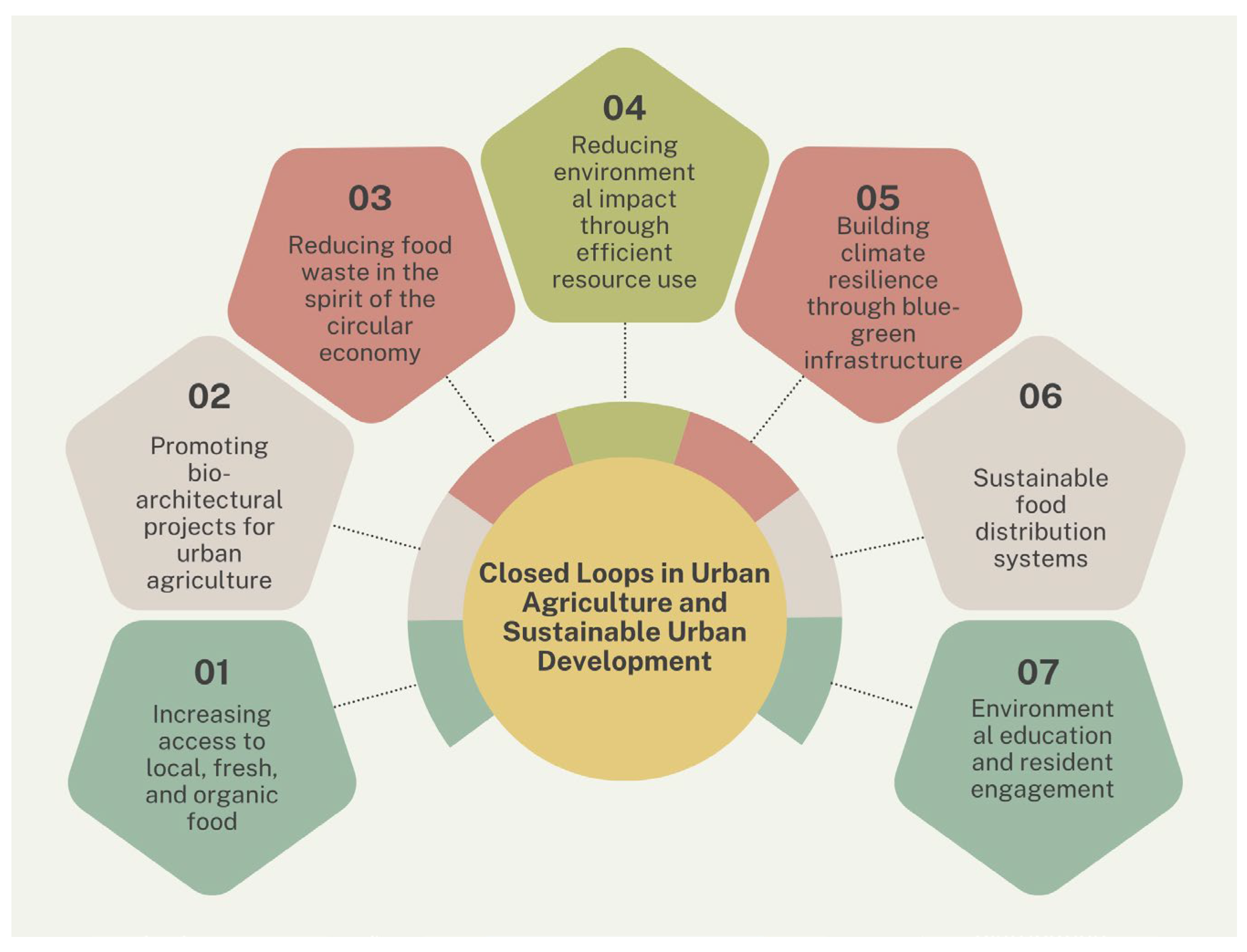
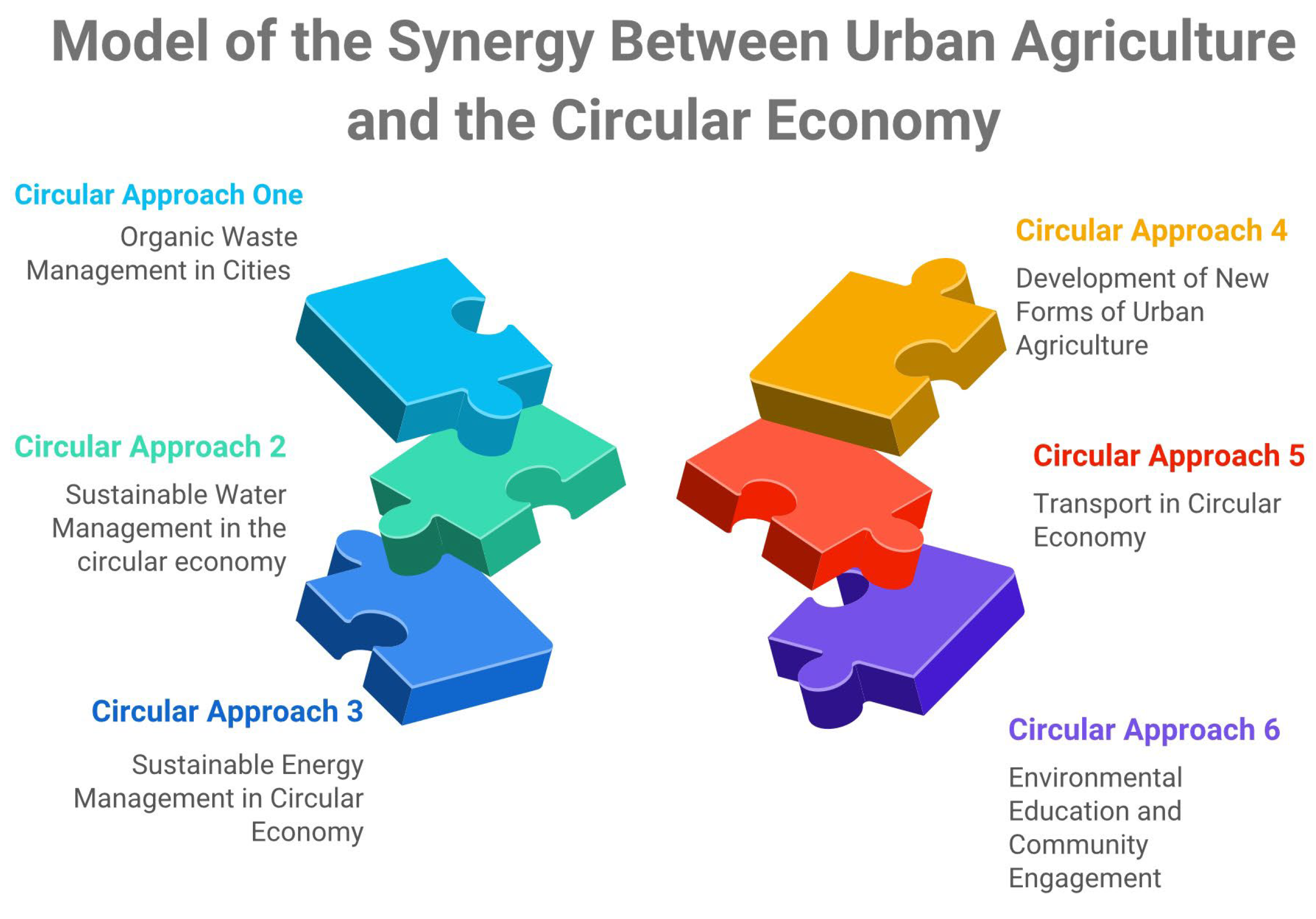
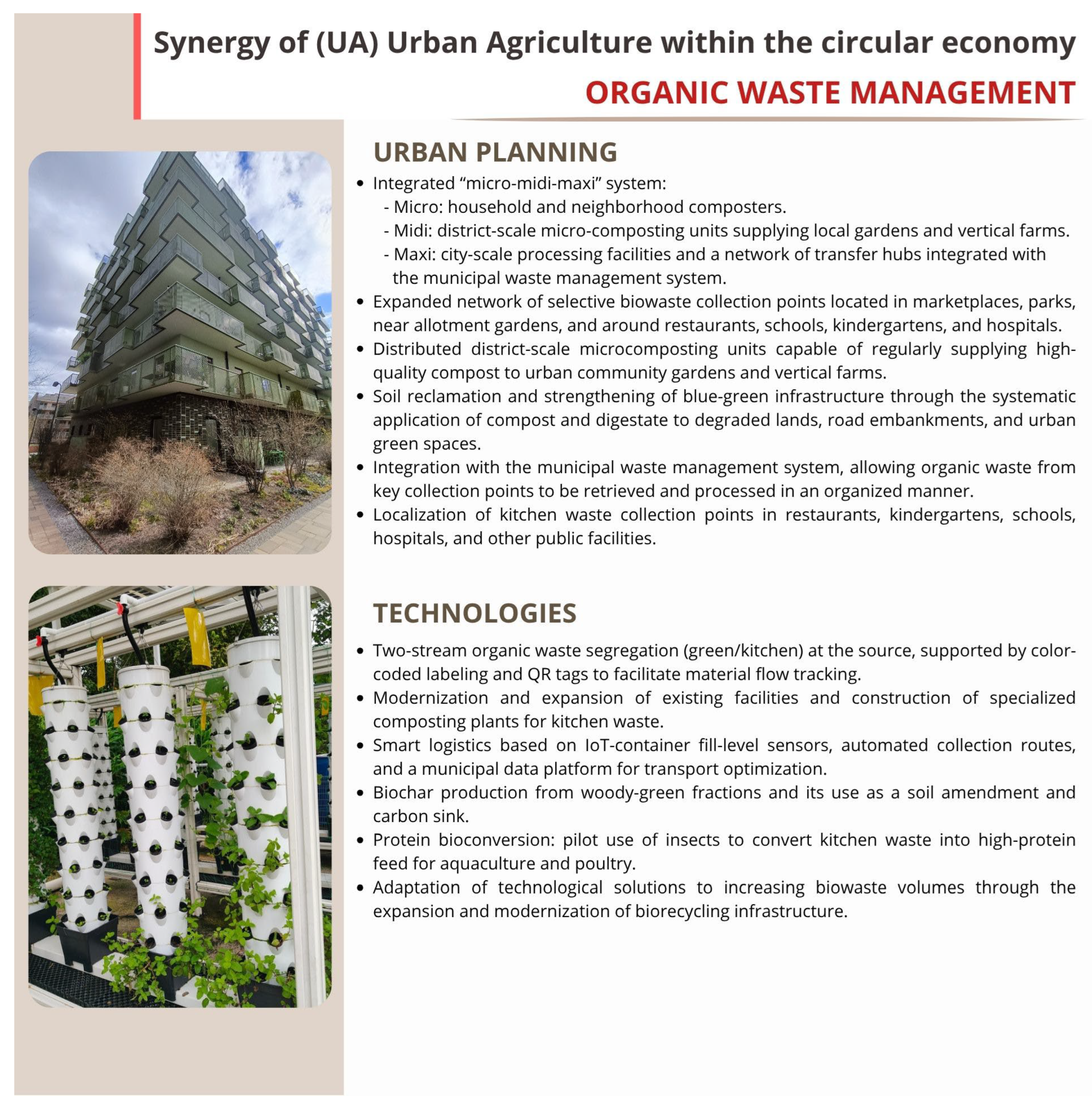

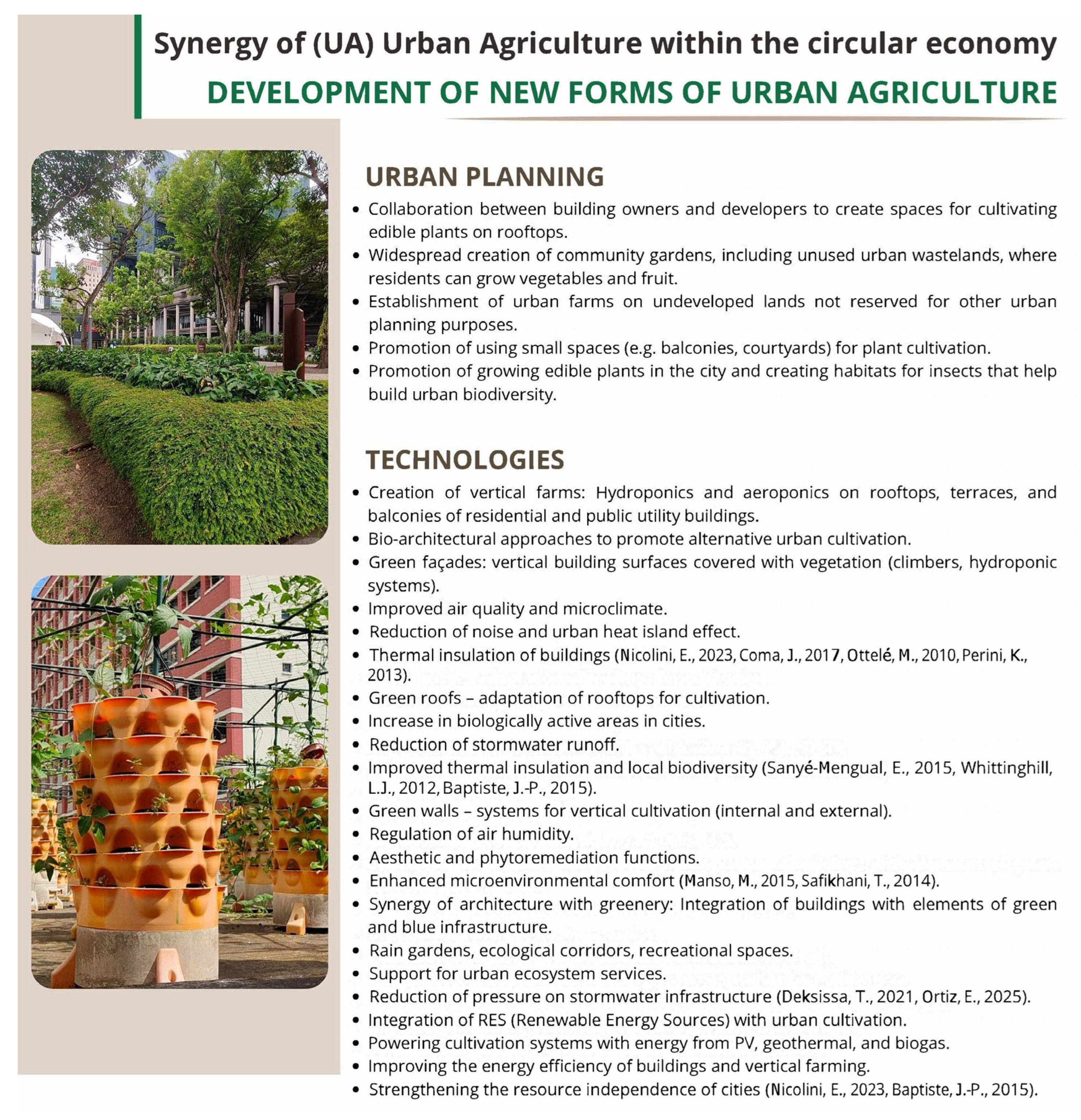

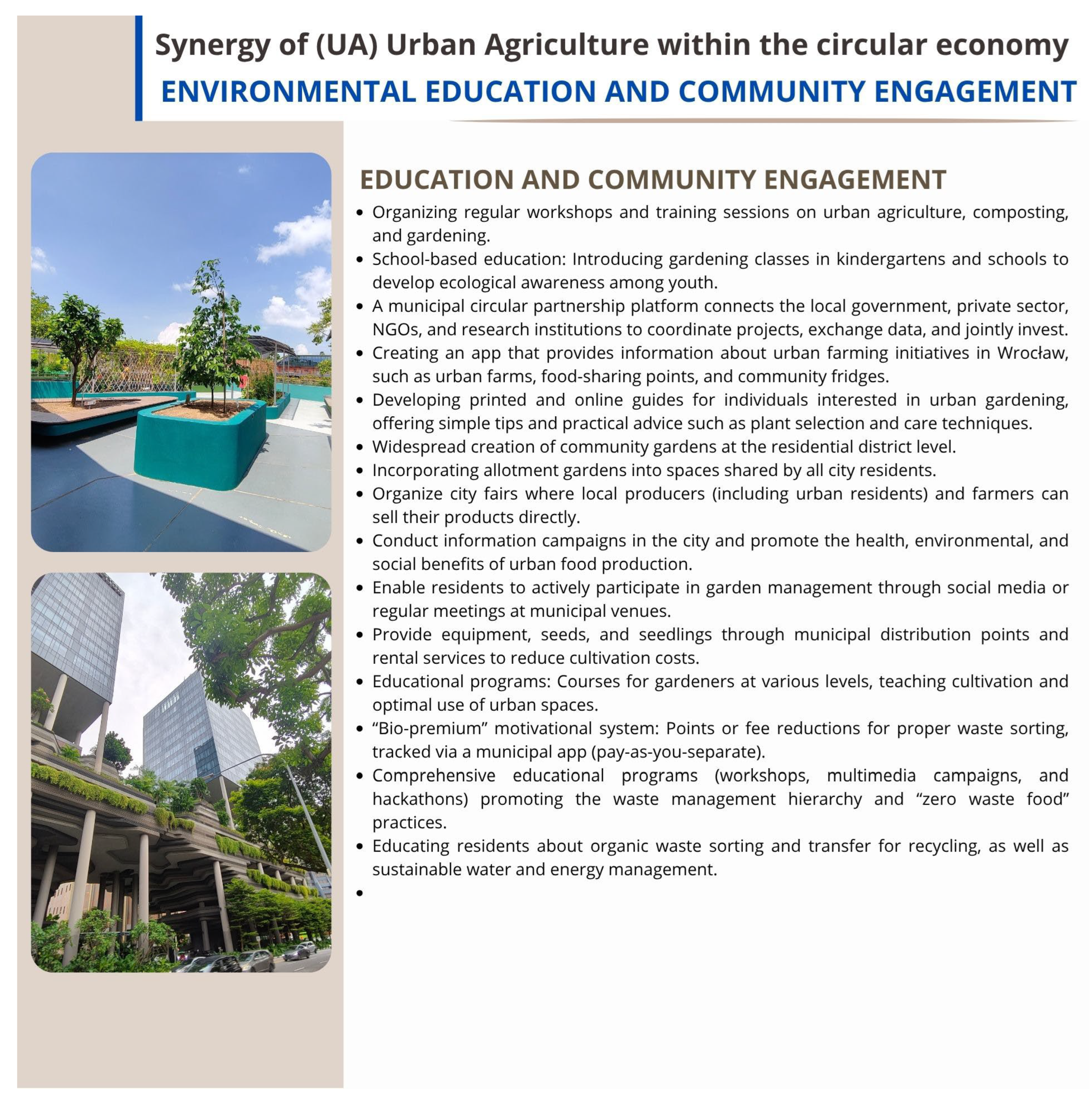



| Categories | Micro | Midi | Maxi |
|---|---|---|---|
| Spatial scale | Single location/building; small indoor/outdoor units | District/cluster; selected infrastructure facilities | City/metropolitan scale; system-level planning |
| Technology | Simple CEA; low-power hydro/aeroponics; modular systems | Integrated CEA; heat and CO2 recovery; monitoring/IoT | Connection standards and requirements; PPA/ESCO models |
| Resources | Water saving; low energy use; basic reuse where possible | Energy–water balance; heat/CO2 loops; retention systems | Network mix; tariffs; integration with urban circulation systems |
| Logistics | On foot/bicycle; ultra-short supply chain | District hubs; cold chain; cargo Logistics | Integration with urban mobility/logistics plans (SUMP) |
| Economy | Low CAPEX; low OPEX; high educational value | Medium CAPEX; testing of business models | Financial instruments; incentives; PPP frameworks |
| Social/Education | Learning by doing; community engagement; quick outcomes | District programs; workshops; partnerships | Food policy; citywide programs; social acceptance |
| Risks/Limitations | Maintenance continuity; volunteer fatigue; local approvals | Energy costs; sanitary procedures; coordination of multiple actors | Interdepartmental coordination; regulatory clarity; public acceptance |
| Categories | Micro | Midi | Maxi |
|---|---|---|---|
| What works | User proximity; quick activation; visible benefits; education and awareness | Integration of resource cycles; measurable outcomes; verification of business models | Policy integration; economies of scale in procurement and data; long-term stability |
| What limits | Dependence on volunteer time; limited volume; varied maintenance quality | Energy costs; sanitation compliance; coordination among multiple stakeholders. | Bureaucratic silos; inconsistent regulations; challenges of social acceptance |
| What is needed for implementation | Simple service contracts; light procedures; micro-grants; training kits | Energy contracts (PV, heat recovery, PPA); SOPs; district support office | One-stop permits; unified guidelines; incentives and PPPs; public communication |
| Categories | Micro | Midi | Maxi |
|---|---|---|---|
| Energy | Low to medium power; dependent on lighting; no or minimal HVAC systems | Moderate demand; possible heat and CO2 recovery; IoT monitoring | Dependence on energy mix; PPA/ESCO possible; tariff optimization |
| Water | Significant savings through CEA; precise dosing | Water and energy balance; retention and circulation; stable consumption | Urban policies on retention and reuse; standardization of indicators |
| CAPEX/OPEX * | Low CAPEX; low to medium OPEX; high educational value | Medium CAPEX; medium OPEX; revenue models under verification | High CAPEX (system level); OPEX optimized by scale |
| Supply Chain | Ultra-short (on-site, walking/bicycle); no or small cooling facilities | District level (hubs, cold storage, cargo); short routes | City level (integration with SUMP/urban logistics); data integration |
| Social Acceptance | Usually high at the local level; strengthened through educational programs | Variable; increases with the visibility of results and partnerships | Requires food policy and public communication |
| Strengths (S) | Weaknesses (W) | Opportunities (O) | Threats (T) |
|---|---|---|---|
| S1 High water-use efficiency in CEA systems and precise dosing | W1 Energy intensity of certain solutions (lighting, HVAC) and sensitivity to the energy mix | O1 Policy and funding frameworks (climate, CE, food security, BGI/SuDS/LID) | T1 Energy price volatility and uncertainty of operating costs |
| S2 Year-round controlled production and stable supply | W2 High initial costs (CAPEX) and longer payback period | O2 Access to degraded and underground spaces with revitalization potential | T2 Regulatory uncertainty and complex sanitation requirements |
| S3 Proximity to consumers and shortening of supply chains (food miles) | W3 Lack of standardized evaluation indicators (TEA/LCA; energy, water, emissions) | O3 Decarbonization of grids, development of renewable energy and energy storage, PPA/ESCO agreements | T3 Limited social acceptance/NIMBY attitudes |
| S4 Resource synergies: heat and CO2 recovery, water retention and reuse | W4 Limited range of crops economically viable at large scale | O4 Digitalization and automation (IoT, monitoring, last-mile logistics) | T4 Competition for space and institutional silos within the city |
| S5 Social and educational functions, building social capital | W5 Varied organizational maturity and operational risk at the start | O5 Cooperation with education, tourism, and public health | T5 Disruptions in supply chains of components and materials |
| S6 Use of underutilized spaces (rooftops, façades, underground areas) | - | - | - |
| Code | Factor | Weight | Score (−5… +5) | Weighted Result | Comments |
|---|---|---|---|---|---|
| Strengths (S) | |||||
| S1 | Resource synergies: heat and CO2 recovery, water loops | 0.35 | 4 | 1.40 | Integration with urban infrastructure |
| S2 | High water-use efficiency in CEA systems | 0.30 | 5 | 1.50 | Precise dosing and closed cycles |
| S3 | Proximity to consumers and shortening of food miles | 0.20 | 3 | 0.60 | Freshness, lower losses, reduced transport |
| S4 | Year-round, controlled production | 0.15 | 3 | 0.45 | Stable supply regardless of weather |
| Suma (S) | 1.00 | 3.95 | |||
| Weaknesses (W) | |||||
| W1 | High energy consumption (lighting, HVAC) and sensitivity to energy mix | 0.40 | −5 | −2.00 | Impact on OPEX and carbon footprint |
| W2 | High initial investment costs (CAPEX) | 0.30 | −4 | −1.20 | Longer payback period |
| W3 | Lack of standardized evaluation indicators (TEA/LCA) | 0.20 | −3 | −0.60 | Difficulty in comparison and reporting |
| W4 | Limited range of crops profitable at large scale | 0.10 | −2 | −0.20 | Dominance of leafy greens, herbs, mushrooms |
| Suma (W) | 1.00 | −4.00 | |||
| Opportunities (O) | |||||
| O1 | Policy frameworks (climate, CE, food security, BGI/SuDS/LID) | 0.35 | 4 | 1.40 | Support programs and funding mechanisms |
| O2 | Access to degraded and underground spaces | 0.25 | 3 | 0.75 | Lower alternative land cost |
| O3 | Network decarbonization and renewable energy/storage (PPA/ESCO) | 0.20 | 4 | 0.80 | Reduction in energy costs and footprint |
| O4 | Digitalization and automation (IoT, monitoring, logistics) | 0.20 | 3 | 0.60 | Higher control and efficiency |
| Suma (O) | 1.00 | 3.55 | |||
| Threats (T) | |||||
| T1 | Energy price volatility and uncertainty of OPEX | 0.40 | −4 | −1.60 | Strong impact on profitability |
| T2 | Regulatory uncertainty and sanitation requirements | 0.25 | −3 | −0.75 | Complex implementation procedures |
| T3 | Limited social acceptance/NIMBY attitudes | 0.20 | −2 | −0.40 | Need for communication and transparency |
| T4 | Disruptions in supply chains of components and materials | 0.15 | −3 | −0.45 | Risk of delays and additional costs |
| Suma (T) | 1.00 | −3.20 | |||
| Rank | Code | Quadrant | Short Description | Weight | Score (−5… +5) | Weighted Result |
|---|---|---|---|---|---|---|
| 1 | W1 | W | High energy consumption (lighting, HVAC) and sensitivity to the energy mix | 0.40 | −5 | −2.00 |
| 2 | T1 | T | Energy price volatility and uncertainty of OPEX | 0.40 | −4 | −1.60 |
| 3 | S2 | S | High water-use efficiency in CEA systems | 0.30 | 5 | 1.50 |
| 4 | S1 | S | Resource synergies: heat and CO2 recovery, water loops | 0.35 | 4 | 1.40 |
| 5 | O1 | O | Policy frameworks (climate, CE, food security, BGI/SuDS/LID) | 0.35 | 4 | 1.40 |
| 6 | W2 | W | High initial investment costs (CAPEX) | 0.30 | −4 | −1.20 |
| 7 | O3 | O | Network decarbonization and renewable energy/storage (PPA/ESCO) | 0.20 | 4 | 0.80 |
| 8 | O2 | O | Access to degraded and underground spaces | 0.25 | 3 | 0.75 |
| 9 | T2 | T | Regulatory uncertainty and sanitation requirements | 0.25 | −3 | −0.75 |
| 10 | S3 | S | Proximity to consumers and shortening of food miles | 0.20 | 3 | 0.60 |
| Opportunities (O) Strategies for Leveraging Opportunities | Threats (T) Strategies for Reducing Risks |
|---|---|
| Strengths (S) | |
| SO—Use strengths to seize opportunities | ST—Use strengths to mitigate threats |
| SO-1: Couple heat and CO2 recovery with the decarbonizing grid and renewable energy sources (RES), launching pilot projects in public facilities and transport hubs (S4 × O3/O1). | ST-1: Secure energy costs through PPA contracts and heat recovery, using resource synergies to reduce vulnerability to price fluctuations (S4 × T1). |
| SO-2: Use water efficiency and proximity to consumers to supply resilience hubs and public catering, ensuring stable year-round provision (S1/S2/S3 × O1/O2). | ST-2: Use proximity and steady supply to build stable distribution channels, reducing the effects of supply chain disruptions (S2/S3 × T5). |
| SO-3: Develop educational and tourism programs around midi-scale installations to strengthen social license and increase demands for local products (S5 × O5/O4). | ST-3: Standard hygiene procedures and quality monitoring, combined with public visibility of projects, strengthen trust and reduce NIMBY risks (S5 × T2/T3). |
| Weaknesses (W) | |
| WO—Overcome weaknesses by taking advantage of opportunities | WT—Minimize weaknesses and avoid threats |
| WO-1: Introduce a simplified set of indicators (TEA/LCA-lite) into procurement and grant documentation to standardize reporting and improve comparability (W3 × O1/O4). | WT-1: Establish regulatory sandboxes and one-stop permitting with clear sanitation guidelines to lower implementation barriers (W3/W5 × T2/T4). |
| WO-2: Gradually reduce CAPEX through PPP/ESCO models and long-term leases of unused underground spaces, accelerating the learning curve (W2 × O2/O3). | WT-2: Implement modular scalability and phased investments to reduce CAPEX risk and adapt the energy profile to market conditions (W1/W2 × T1). |
| WO-3: Broaden crop portfolios and technological modules by integrating systems with varying intensity and energy demand (W4 × O4/O3). | WT-3: Develop service contracts and short supply chains for components to reduce vulnerability to disruptions (W5 × T5). |
Disclaimer/Publisher’s Note: The statements, opinions and data contained in all publications are solely those of the individual author(s) and contributor(s) and not of MDPI and/or the editor(s). MDPI and/or the editor(s) disclaim responsibility for any injury to people or property resulting from any ideas, methods, instructions or products referred to in the content. |
© 2025 by the authors. Licensee MDPI, Basel, Switzerland. This article is an open access article distributed under the terms and conditions of the Creative Commons Attribution (CC BY) license (https://creativecommons.org/licenses/by/4.0/).
Share and Cite
Zaręba, A.; Krzemińska, A.; Adynkiewicz-Piragas, M.; Jia, H. Urban Harvesting: Building Resilience Through Circular Agriculture. Sustainability 2025, 17, 10560. https://doi.org/10.3390/su172310560
Zaręba A, Krzemińska A, Adynkiewicz-Piragas M, Jia H. Urban Harvesting: Building Resilience Through Circular Agriculture. Sustainability. 2025; 17(23):10560. https://doi.org/10.3390/su172310560
Chicago/Turabian StyleZaręba, Anna, Alicja Krzemińska, Mariusz Adynkiewicz-Piragas, and Haifeng Jia. 2025. "Urban Harvesting: Building Resilience Through Circular Agriculture" Sustainability 17, no. 23: 10560. https://doi.org/10.3390/su172310560
APA StyleZaręba, A., Krzemińska, A., Adynkiewicz-Piragas, M., & Jia, H. (2025). Urban Harvesting: Building Resilience Through Circular Agriculture. Sustainability, 17(23), 10560. https://doi.org/10.3390/su172310560








